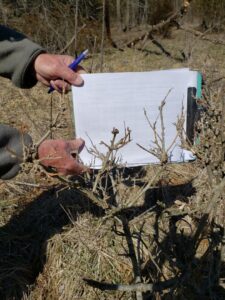Winter Twig Browse Survey conducted at CANS
by Allison Vaughn, Communications Chair
As mentioned in the March issue of the Chat, Columbia Audubon is beginning to examine the impacts of deer herbivory on plant life at CANS. For two days in early March, I joined Bill Mees who oversees management of CANS to collect deer browse information on the site’s shrubs. In late winter when supple buds begin to form on woody shrubs, deer will clip them off which leads to sprawling shrubs or in extreme cases, death to the shrub. The challenge Bill and I had on our browse survey was the almost absence of a shrub layer, which is very important to nesting birds and other biota. In the coming weeks or months, we will be making plans to install a deer browse exclosure to keep deer out of a small area to see what herbaceous plants grow there that haven’t been eaten by deer.
Most of the survey took us into the woodlands, as deer often congregate and apply a lot of browse pressure in developed areas. However, we measured the percent of browsed twigs in the CANS parking lot on the rough-leafed dogwood to find that 85% of the twigs had been browsed. The results of the browse survey show that many shrubs and small trees such as black oak and bur oak are being browsed, with black oak a generally unpreferred browse species, but still experiencing 50% browsed twigs and 50% unbrowsed. Bur oak, a member of the white oak group, 67% of the twigs were browsed. There is very little oak regeneration at CANS due to deer pressure and lack of prescribed fire.
Other results are as follows: Redbud: 91% browsed; Burning Bush (which will be removed because it is invasive): 41% browsed; Pawpaw (which is not preferred but abundant): 44% browsed; Box elder: 51% browsed. Again, there are very few shrubs at CANS, and the recent shrub planting exercise included labor intensive caging around each sapling in hopes that they will grow above the level that deer can reach.

